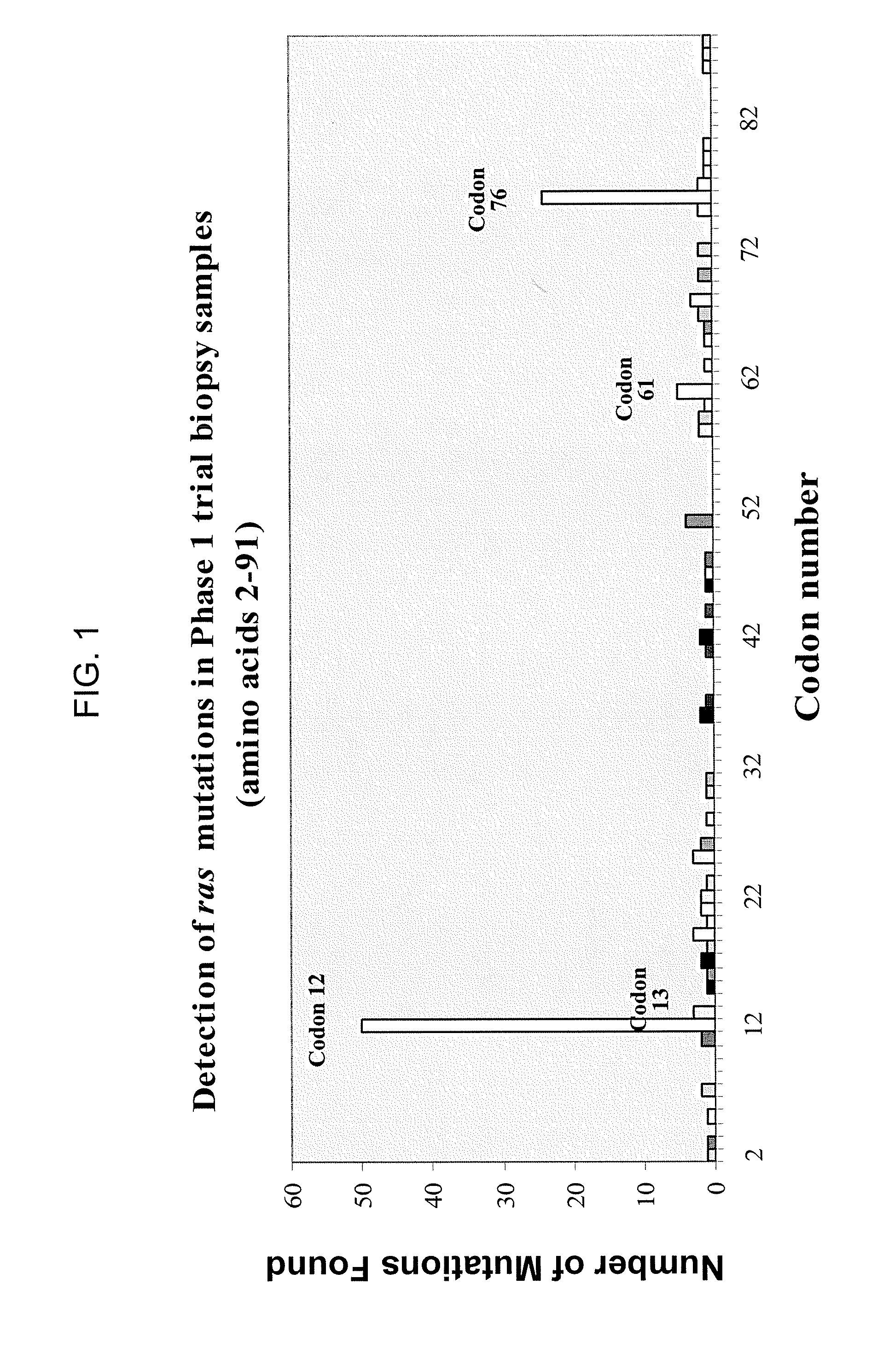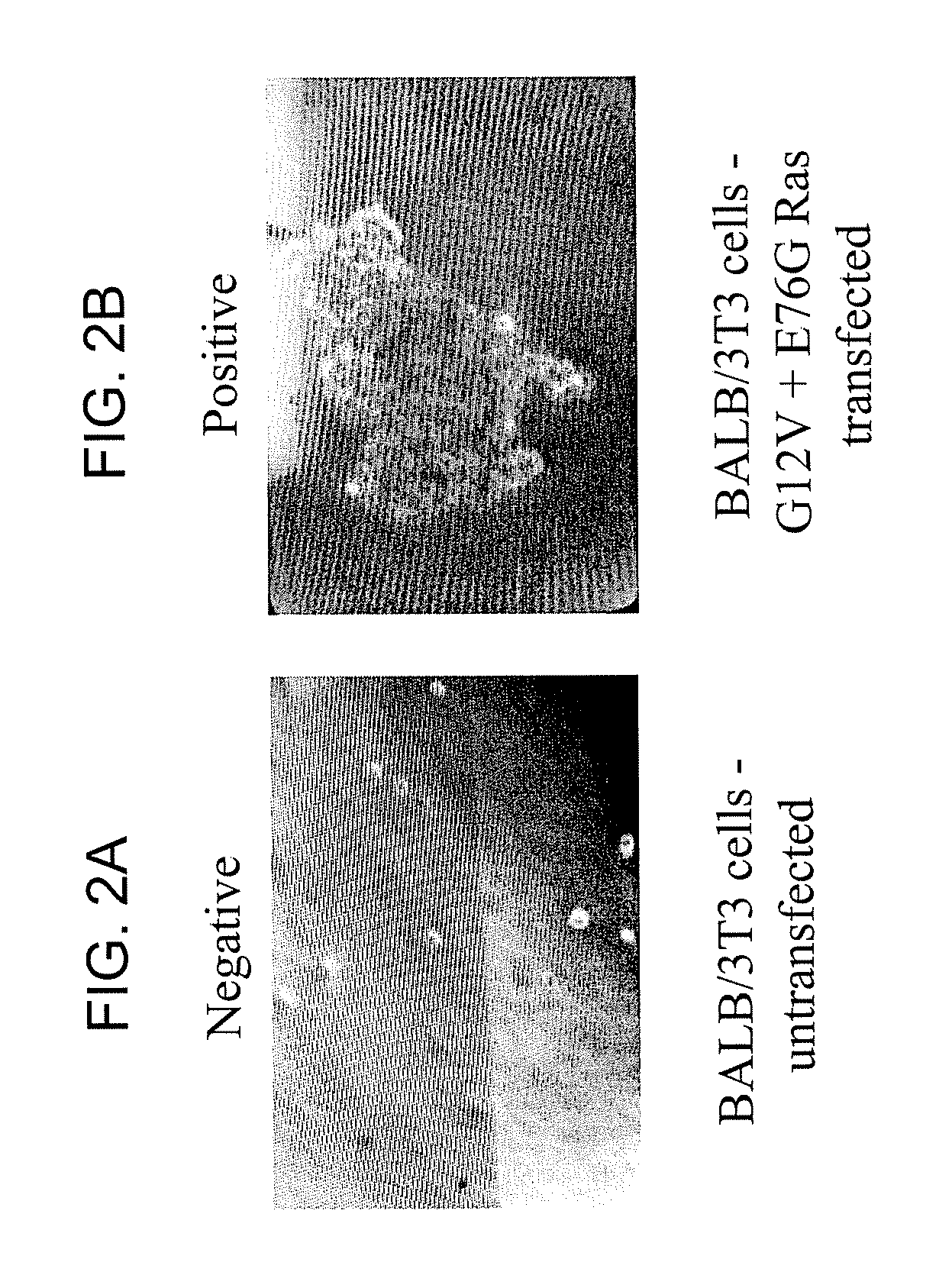Ras mutation and compositions and methods related thereto
a technology of compositions and methods, applied in the field of ras mutation and compositions and methods related thereto, can solve the problems of difficult treatment, high mortality rate, and relatively unresponsiveness, and achieve the effect of determining the susceptibility of patients
- Summary
- Abstract
- Description
- Claims
- Application Information
AI Technical Summary
Benefits of technology
Problems solved by technology
Method used
Image
Examples
example 1
[0228] The following example describes the identification of a new Ras mutation in tumors evaluated during a Phase 1 immunotherapy trial of whole, heat-killed yeast expressing mutated Ras proteins (Tarmogens).
Materials and Methods (Used in Examples 1 and 2):
[0229] Patients. 149 patients with pancreatic cancer, colorectal cancer or non-small-cell lung cancer were enrolled in a phase I trial (GlobeImmune, Inc.) of targeted molecular immunotherapy with whole, heat-killed yeast expressing mutated Ras proteins (Tarmogens). Biopsy samples of patient tumors were genotyped for ras mutations to identify subjects with product-related mutations to be enrolled in the immunotherapy trial.
[0230] Tissue samples and genomic DNA isolation. Tumor sample of each patient was received as either paraffin embedded block or slides mounted with sections cut from paraffin block. Tumor cells were isolated by LCM (laser capture microscopy) or microscopic scalpel scraping from stained (HistoGene Staining So...
example 2
[0242] The following Example demonstrates that Ras E76 mutations are transforming, and further, that Ras E76 mutations synergize with Ras G12 mutations to increase the oncogenicity of a tumor.
[0243] Ras E76G and E76K mutations were confirmed as transforming in non-clinical studies. Of particular interest, coupling codon 76 and 12 mutations resulted in tumor growth synergy. G12V, E76G and E76K single mutations or double G12V-E76G mutations were introduced into the mouse K-ras gene and then transfected into BALB / 3T3 fibroblasts. Cells transfected with ras harboring G12V or E76K alone, or the G12V-E76G double mutation formed colonies in soft agar (see FIGS. 2A and 2B and Table 3).
TABLE 3E76 as a Transforming MutationClonemRNA transcript(K-ras genotypeof transfected rasExogenous RasColonytransfectedgeneprotein expressionformation inBALB / 3T3 cells)(by RT-PCR)(western blot)soft agarwild-type (WT)++−G12V++++++G12V + E76G+++++++E76G++−E76K++++pUP (empty vector)−−−Balb3T3−−−(untransfected...
example 3
[0246] The following experiment describes a yeast-based vaccine comprising a yeast vehicle and fusion protein comprising a Ras E76 mutation.
[0247]Saccharomyces cerevisiae was engineered to express a multi-domain mutant Ras fusion protein under the control of the copper-inducible promoter, CUP1. The fusion protein is a single polypeptide with the following sequence elements fused in frame from N- to C-terminus (the amino acid sequence of the fusion protein being represented herein by SEQ ID NO:14): 1) the sequence MADEAP (SEQ ID NO:1) to confer stability of the nascent yeast-expressed heterologous protein during cell culturing (positions 1 to 6 of SEQ ID NO:14); 2) a fragment of Ras containing the amino acid position 12 with respect to a wild-type Ras protein, wherein the glycine at position 12 is substituted with a cysteine (positions 7-52 of SEQ ID NO:14; with the position 12 mutation being at position 17 of SEQ ID NO:14); 3) a fragment of Ras containing the amino acid position 61...
PUM
| Property | Measurement | Unit |
|---|---|---|
| melting temperatures | aaaaa | aaaaa |
| temperature | aaaaa | aaaaa |
| temperature | aaaaa | aaaaa |
Abstract
Description
Claims
Application Information
 Login to View More
Login to View More - R&D
- Intellectual Property
- Life Sciences
- Materials
- Tech Scout
- Unparalleled Data Quality
- Higher Quality Content
- 60% Fewer Hallucinations
Browse by: Latest US Patents, China's latest patents, Technical Efficacy Thesaurus, Application Domain, Technology Topic, Popular Technical Reports.
© 2025 PatSnap. All rights reserved.Legal|Privacy policy|Modern Slavery Act Transparency Statement|Sitemap|About US| Contact US: help@patsnap.com



